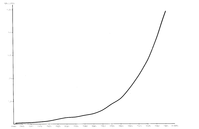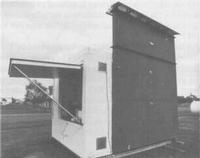


Chapter 8
I Part 1: Communications
i Before the Telegraph
ii Electrical Communication Before Federation
iii Federation to the End of the Second World War
iv Post-war and on to 1975
v 1975 ONWARDS
II Epilogue
III Part 2: Early Australian Computers And Computing
IV Acknowledgements
References
Index
Search
Help
Contact us

1975 ONWARDS (continued)
In Australia, as elsewhere in technically advanced countries, information is tending to become one of the factors underpinning society and the new technologies saw a range of services, in addition to those briefly described, becoming available at a rapid rate.Despite the introduction of new services, the period saw continued strong growth in the basic telephone service, as illustrated in Fig. 28, with trunk traffic growing at around twice the rate of increase in subscribers. A great deal of system design and technical innovation was necessarily involved in meeting these demands, quite apart from those which have been specifically identified in the introduction of SPC local exchanges, digital transmission and new services, and a range of technologies was brought to bear on the task of extending the standard automatic telephone service into rural and remote areas. For example, as local exchanges were converted to automatic using ARK equipment, the latest in cable technology, such as jelly filled to reduce moisture penetration, was employed; improved VHF radio concentrator systems were developed; special long distance telephones were supplied. As all these were, however, distance limited in terms of both cost and performance, new approaches were required if a nationwide standard automatic service, capable of providing STD and ISD, as well as telex and low speed data, was to be achieved. Attention was directed first to the practicability of exploiting satellite technology, but extensive studies indicated that having regard to the number of potential services in remote areas, as disclosed by a comprehensive survey, such an approach was, at least at the current stage of satellite technology, too expensive for individual services. However, as described later, Aussat's facilities are being utilised to provide television and radio services to remote areas, as well as telephone services to larger groups using Telecom's ITERRA services. In Queensland, the State Government is also using Aussat in developing its own Q-NET service.

The Research Laboratories then studied the problem of provision of a standard subscriber's service in a large area with very low subscriber density and concluded that a solution could be found by using a combination of concentrator techniques, digital radio and solar power in the form of a Digital Radio Concentrator System (D.R.C.S). Specifications were then developed including subscribers' facilities embracing automatic operation, STD, ISD, Telex, low speed data and facsimile, with the equipment to be engineered to operate in a harsh environment. NEC was the successful tenderer for the development and supply of the DRCS system.
The DRCS involves essentially three elements, the exchange unit, the repeater and the subscribers' unit. The system is dimensioned to carry up to 127 subscribers, with repeater spacings of 40 to 50 kms and with a maximum of 13 repeaters in any one line, giving a nominal limit of around 600 kms between a subscriber and the exchange.[64] As the repeaters will be in remote areas, where extremes of temperature are regularly experienced, a passively cooled shelter is being developed which uses the draught of a solar chimney to drive a heat exchange within the building.

Organisations in Australian Science at Work - AUSSAT; N.E.C. Australia; Telecom Australia (Australian Telecommunications Commission)
 |
Australian Academy of Technological Sciences and Engineering |  |
© 1988 Print Edition page 598, Online Edition 2000
Published by Australian Science and Technology Heritage Centre, using the Web Academic Resource Publisher
http://www.austehc.unimelb.edu.au/tia/573.html